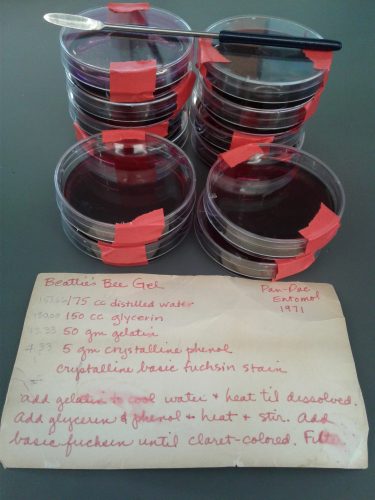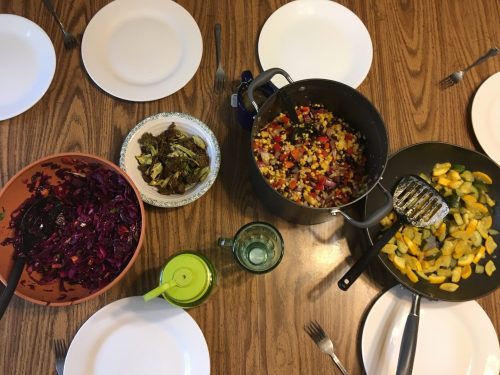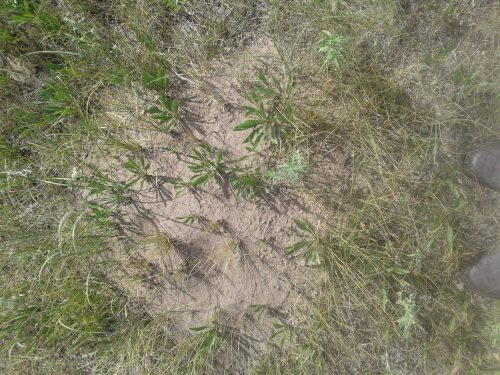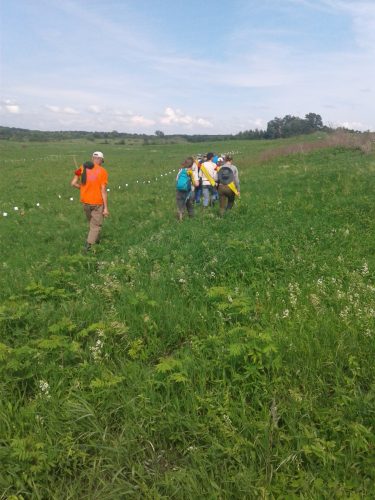|
|
Tomorrow I will be coming back to CBG to work for a few days over break and I’m very excited! I just wanted to take the time and explain some of the things that I’ve done since the school year started. I finished entering two data sets of data; the data from pollen in the bank and the maternal repaints (technically I entered one and a half because Zeke filled out the pollen in the bank data with me). I’ve also been showing our new volunteer, Nate Scheerer, around the lab sense he’ll be helping me count the pollen on the styles Zeke, Mia, and I collected this summer out in Minnesota. But what I’ve completed that I was most proud of was making the fuschin dye that we’ll be using to stain the styles. Even though I was nervous when making the gel, the product turned out great! One thing that I recommend before making the gel is having all the materials that you’ll need nearby so you can keep a close eye on the gel (and so the people in the stockroom don’t get annoyed with seeing you every five minutes). I’m looking forward to a productive few days at CBG!
 Just a small amount of the gel that I made in the lab.
This will be my last Flog Entry of the field season so along with summarizing today, I’ll also include a summary of what (Zeke and) I have worked on this summer (Hopefully tommorow).
It was a normal day. In the morning, the team went out to P1 to do rechecks (nothing better than rechecks in P1 under the morning sun). After completing a few rows in P1, we split into smaller groups for the remainder of the morning. Morgan, Michael and I went to Riley (the site, not the person) for demo. I had quickly become a master using the GPS, Darwin, over the summer, but Chekov is a whole different beast. After a few points, I relinquished the reigns of Chekov and let Michael handle it. After demo, the three of us returned back to Hjelm for lunch where we talked about the project status update form that needs to be completed before we leave for the summer. Zeke and I figured that (once again) we would collaborate and write ours together. In the afternoon I went out to Staffonson to help Kristen and Julia move their traps. Being the trap master that I am (because of all the training that I’ve had at the CBG), Kristen, Julia and I were able to move the traps in a timely manner. Back at Hjelm, I harvested some Bouteloua before heading back to The Roost with Brigid and Zeke.
 The team picking fresh Balagadoo from P1 On our car ride back we thought about whether or not we would want the ability to see into the future (very deep stuff). Back at The Roost Mia prepared her last meal of the summer, which was delicious. After finishing dinner, Kristen came by, which means we were forced to put our phones away and socialize.
 An aesthetically pleasing meal
August 5th 2018 marks the day that Team Echinacea returned to Glacial Ridge National Wildlife Refuge. However, only a few members (Stuart, Gretel, Kristen, Michael, Mia, Zeke and I) embarked on this journey to collect seed set data. We left the Roost around 6:00 AM. Much of the car ride is a blur to me (1. Because I was in and out of consciousness and 2. Because I’m writing this at 8:00 PM, a solid 15 hours later). However, I do remember Zeke and Kristen discussing the definition/criteria for a city. They came to a conclusion that a city must have four (or more) structures that are greater than four stories. I also remember Zeke’s unique bird classifying system, which included the categories of; big bird, little-big bird, big-medium bird, medium bird, small-medium bird, big-small bird and small bird.
 Mia was able to find an orchid that didn’t have a flag marking it by tapping into the Force. Once we arrived at the site, I thought about Star Wars alot (for some odd reason). I imagined that Stuart and Gretel were our Jedi Masters, while the rest of us were padawans accompanying them on a mission. The seven of us were able to work efficiently to collect the seed set data from the orchids in a just a few hours (that’s the power of harmonic convergence for ya). As a Team Echinacea tradition, we got F’real milkshakes after a job well done. Instead of heading straight to Alexandria, we went to a site called Agassiz Dunes. It was nice to go out and see a new site, even if it was was covered with poison ivy.
 “I don’t like sand. It’s coarse and rough and irritating and it gets everywhere.” – Anikan Skywalker After visiting Agassiz Dunes, we headed back to Alexandria where we meet up with the remaining members of the Roost. After a great meal at Qudoba, we returned home and reminisced about our actioned packed weekend!
Today seemed like any other day. Zeke and I were recording visits, while Mia worked on her hand crosses. However, a rumbling in the distance distracted us from our work. It was a rare sighting of other members of Team Echinacea. Even though we (CoW Bee) were confused about these other people we were able to record visits and hand crosses. When we returned to Hjelm we met Lea, a PhD student who drove up from CBG. In the afternoon we measured in P1. For dinner Riley made tacos for Taco Tuesday (Not sure what else he would have made today). We ended the night with a few rounds of 10 person Werewolf. Tomorrow it looks like it’ll rain in the morning, but hopefully the team will be able to go out and work on our projects.
After surviving Friday the thirteenth, Zeke and I decided to go out to P2 to see if we could get more visits for Pollen in the Bank (Pollinators deposit and withdrawal pollen from the head like it’s a bank). We stayed out there for 2 hours and recorded six bee visits. Once we returned to the Roost, we decided to look at our horoscopes. Most of the qualities don’t match up,but as Kristen said, “the chart doesn’t lie”. Along with horoscope readings, we discussed our vocal ranges and figured out what part everybody would sing. (Of course) I’m the bass in the group. For dinner Zeke prepared onions, potatoes, bacon and mushrooms. The onions were so strong that before Zeke cut one open, the members of the Roost had tears in their eyes. After dinner, we decided to go into town and watch The Incredibles II. It turned out to be a great movie with just the right amount of social commentary. I’m looking forward to what tomorrow holds!
As of late the Roost has been obsessed with pirates thanks to Riley’s love for chanties. Because of this I decided to write a flog post as if Team Echinacea were as a pirate crew. Enjoy!
June 25th, 2018. A storm is brewing. As the crew traveled to the docks where the S.S. Hjelm was stationed we sang some of our favorite chanties like Boys by Charli XCX. Once we arrived at the docks we broke into smaller groups. A group of us, led by Captain Stuart, marked out where our precious purple coneflower treasure was in p1. (Not all of this can be paralleled into a pirate based theme, but I’m trying my best).
 Andy standing stoically as the storm approaches. Knowing that the worst is inevitable, but still hoping for the best The storm that was brewing passed over as we headed in for meal time. We were meet with a new crew member named Amy who quickly won us over with brownies (Not sure if pirates ate brownies, but couldn’t think of the equivalent of brownies for pirates). Once our meal was finished, Captain Jennifer took us out to p2 where we also marked where our precious purple coneflower treasure was buried. As the day came to an end, the crew members who lived in the Roost (and Kristen) returned home where we ate a meal prepared by Andy and talked about tales of native bees (Didn’t know how to incorporate our scientific reading club into the story smoothly, but I think that’ll work). Amy also joined us as we shared tales about native bees.
As dusk began to fall upon the sky, I recorded the events of the day in the captain’s log (The pirate version of the flog) before retiring to my quarters and resting for the tasks that tomorrow holds.
 After risking their lives to mark the precious purple conflower treasure, crew members began the long journey from p2 back to the docks where the S.S. Hjelm was stationed. The work for the day may be over, but more challenges lie ahead. However, with the camaraderie among the members, there is nothing the crew can’t overcome.
Now that my time at the garden is coming to an end, I wanted to include a summary of the projects that I’ve been working on. These three projects include organizing solitary bees that have been collected from yellow pan traps in Minnesota over the past summer, identifying pollen on Echinacea styles and recording the behavior of solitary bees inside emergence traps.
Last summer, several yellow pan traps were placed on the sides of roads in Minnesota in hopes of collecting solitary bees. Once they were collected, each solitary bee was pinned and tagged with a label that included the date, trap number, location, and an ID code. Before logging any of the information into the Roadside Pollinator spreadsheet (this keeps track all of the solitary bees that were collected over the summer in the pan traps) I grouped the specimen together by  taxon. I started grouping more recognizable groups together like Agapostemon virescens before looking at more difficult specimen. Once all grouped together, I would enter the information listed on the label into the spreadsheet. I started with the specimen at the top left corner and worked my way to the bottom right corner of the box. I did it this way to make it easier for anybody to match the information listed in the spreadsheet with that particular specimen in the collection. I was not able to enter every specimen into the spreadsheet, but I did learn key characteristics that will help me distinguish solitary bees when I’m out in the field in Minnesota this summer. taxon. I started grouping more recognizable groups together like Agapostemon virescens before looking at more difficult specimen. Once all grouped together, I would enter the information listed on the label into the spreadsheet. I started with the specimen at the top left corner and worked my way to the bottom right corner of the box. I did it this way to make it easier for anybody to match the information listed in the spreadsheet with that particular specimen in the collection. I was not able to enter every specimen into the spreadsheet, but I did learn key characteristics that will help me distinguish solitary bees when I’m out in the field in Minnesota this summer.
Another project that I worked on while at the garden was looking at images of Echinacea styles to see whether or not foreign pollen grains were present. Every style had three images at varying depths. This was done to get a better look at the pollen present (or absent) on the styles. Over the three weeks that I’ve been at the garden I’ve checked 646 styles for foreign pollen and since each style has three different images, I’ve looked at over 1930 images. You may think I’m an expert by now at recognizing foreign pollen, but I’m still very uncertain about what’s present. However, thanks to Tracie, a system was set up to gauge this uncertainty of whether or not there is foreign pollen present. 
Even though it sounds like I spent most of my time in the lab, I was actually outside collecting solitary bees and testing them in emergence traps majority of the day. Once I come into the lab in the morning, I immediately grab the bee-catching net and plastic vials that are in the lab. I also grab my lucky bucket hat before heading out. I head over to the prairie area in the gardens and try to look for areas that have a dense population of golden-rods. When I first started out this summer I had trouble catching bees, but now with a few weeks of experience underneath my belt I’m able to catch solitary bees with and without the net. I’m able to catch the bees without the net by closing the top of the vial around it while it’s resting atop of flowers. Once I’ve caught a few bees (I catch about four to six solitary bees per day) I head back to the lab and grab the emergence traps. I return back to the prairie area and set up a trap on a south facing slope in order to record the behavior of the bee. I either record footage of the bee or record my observations in a notebook, it all depends on how well I’m able to see through the trap. Once I have my observations/film for the day I return back to the lab and share my findings with Stuart.
On a typical day I would be rotating through these three projects, but I’ve also been able to sit in on a few presentations, including a master thesis defense and a PhD seminar. While at the garden I’ve learned many skills that I hope to continue using this summer in Minnesota!
Today will mark the completion of my first work week here at the garden so I just wanted to summarize some of the tasks I’ve been doing for the past five days. The start of the week was dark and gloomy, like any typical Monday, but it was accompanied with a downpour that left me soaked when walking to the Plant Science Center from the train station. Because of the weather I wasn’t able to go out and collect any solitary bees to use in the emergence traps for Kristen’s experiment. Instead I cleaned a few Echinacea heads, identified foreign pollen and continued to develop my skill for identifying the different bees native in Minnesota. Tuesday was a little better. I wasn’t completely soaked, but it was still cold on the walk in that morning. Once again I wasn’t able to go out and collect any bees. However, I was able to identify a large portion of the pollen slides. Also, I found my own method of cleaning Echinacea heads. I use a smaller pair of tweezers to pluck out the achenes and use the larger pair to brush out any that I may have missed. It’s not the fastest way of cleaning, but I think it’s pretty effective.

Wednesday it was finally warm enough to go out and collect solitary bees. My first day out catching solitary bees didn’t go so well because I didn’t catch any. I did catch a few hoover flies and honey bees and recorded their behaviors in the emergence traps. Before leaving that day, Tracie, Kristen and I set up an emergence trap in the prairie area to see if we would catch anything. The next day when I checked the trap we had a few specimen in the trap. They weren’t bees, but now we know that the traps work! Later that day I was able to collect some solitary bees and record their behavior. Today I was able to catch more solitary bees and record their behavior. This time around I decided to film their behavior in the emergence traps using my phone which I will continue to do. I was able to take a video of a Ceratina that I collected, but because the video size is too large I can’t upload it here. However, I was able to upload another recording of an unidentified solitary bee in the emergence trap. I wasn’t able to put the bee into a vial and identify it back in the lab once it crawled from under the trap, but hopefully I’ll catch another one and identify it next week!
Echinacea Project 2018
Biology, College of Wooster 2020
Research Interests
Ever since I was a kid I’ve always had an interest in forensics. It wasn’t until my second year in college that I started developing a passion for studying ecology. I decided to take a gateway to ecology, evolution, and organismal course as well as an agricultural entomology course and have enjoyed the subject matter. I’m not fully committed to the subject yet, but I am looking forward to working in the field this summer!
Statement
I’m from Chicago, Illinois and I am currently working in the Chicago Botanic Garden’s lab. I’m currently working in the Plant Science Center where I’m cleaning Echinacea heads, identifying pollen, and becoming familiar with the types of bees that visit Echinaceas. When I’m not working in the lab, I’m at home spending time with my family or making music.

|
|








 taxon. I started grouping more recognizable groups together like Agapostemon virescens before looking at more difficult specimen. Once all grouped together, I would enter the information listed on the label into the spreadsheet. I started with the specimen at the top left corner and worked my way to the bottom right corner of the box. I did it this way to make it easier for anybody to match the information listed in the spreadsheet with that particular specimen in the collection. I was not able to enter every specimen into the spreadsheet, but I did learn key characteristics that will help me distinguish solitary bees when I’m out in the field in Minnesota this summer.
taxon. I started grouping more recognizable groups together like Agapostemon virescens before looking at more difficult specimen. Once all grouped together, I would enter the information listed on the label into the spreadsheet. I started with the specimen at the top left corner and worked my way to the bottom right corner of the box. I did it this way to make it easier for anybody to match the information listed in the spreadsheet with that particular specimen in the collection. I was not able to enter every specimen into the spreadsheet, but I did learn key characteristics that will help me distinguish solitary bees when I’m out in the field in Minnesota this summer.

